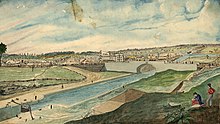Bytown
The founding was marked by a sod turning, and a letter from Governor General Dalhousie which authorized Lieutenant Colonel John By to divide up the town into lots.
Bytown came about as a result of the construction of the Rideau Canal and grew largely due to the Ottawa River timber trade.
[3] The name "Bytown" came about, somewhat as a "jocular reference" during a small dinner party of some officers, and it appears on official correspondence dated 1828.
[4] Joseph Bouchette in the summer of 1828 wrote: The streets are laid out with much regularity, and of a liberal width that will hereafter contribute to the convenience, salubrity and elegance of the place.
The number of houses now built is about 150, most of which are constructed of wood; frequently in a style of neatness and taste that reflects great credit upon the Inhabitants.
McKay also built Rideau Hall (which has since been expanded), and parts of the Union Bridge connecting LeBreton Flats to Hull.
Bytown was initially incorporated on July 28, 1847, and sanctioned by both the Legislative Assembly and the governor, but eventually this was disallowed by the Queen, possibly due to the perceived threat to Ordnance.
[11] Richmond Landing was a small settlement started in 1809 with Jehiel Collins' store, which preceded Bytown in present-day Ottawa.
Collins built a log cabin and store[12][13] on the south shore of the Ottawa River, near the Chaudière Falls area.
The settlement was named Bellows Landing until the fall of 1818, when a group of settlers responsible for the creation of a new road to Richmond, Ontario stayed there.
Corktown, not a town at all, was a series of shanties along the "Deep Cut" section of the Rideau Canal in Ottawa which existed during its construction and were erected by some of its Irish labourers.



